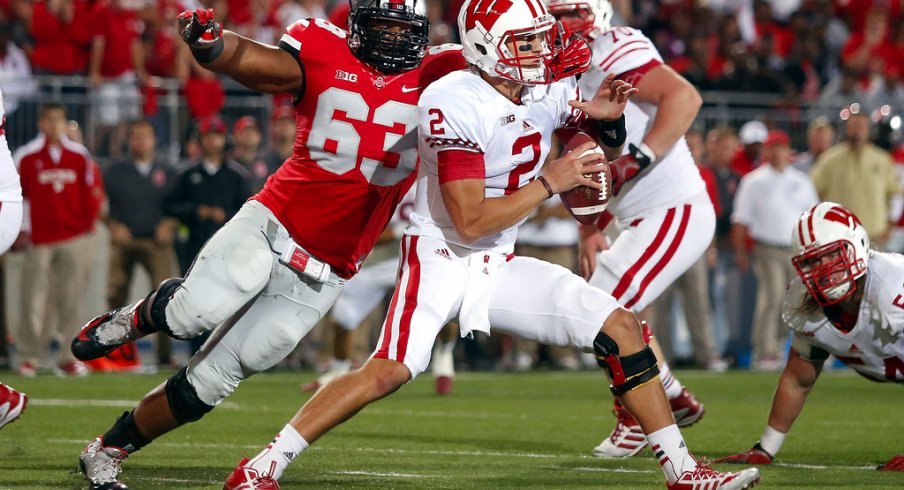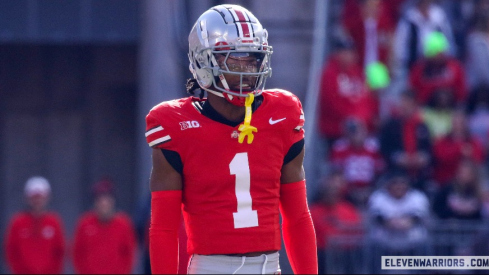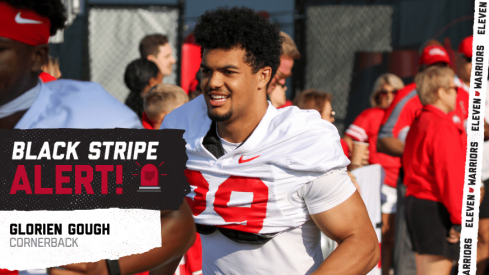Make no mistake, the 2014 Wisconsin Badgers are more than Melvin Gordon.
Though there is yet another star running back in Madison this fall, head coach Gary Andersen hasn't forgotten about the other side of the ball.
Although they had to replace seven starters from the previous year, the Badgers have one of the best defenses in all of college football.Ranking second in total yards allowed, Andersen relied heavily upon this group to rally after an early season loss to Northwestern, coming into the Big Ten championship on a seven-game winning streak.
There is a reason Melvin Gordon is in the national spotlight every week though, as he is currently on pace to break Barry Sanders' single-season rushing record, a record few thought would ever be eclipsed. While many running backs seem to wear down as the season goes on, Gordon has been at his best over the past month averaging over 240 yards-per-game.
With J.T. Barrett now on the sidelines, the Buckeyes will have to play perhaps their best overall game of the season if they hope to win the conference crown and keep their playoff hopes alive. While Gordon is perhaps the biggest playmaker on the field, the Buckeyes still have plenty of their own.
Let's take a look at what Ohio State should expect to see when they hit the field of Lucas Oil Stadium.
Offense
To say Gordon is the focal point of the Badger attack would be modest, as getting the ball in his hands is virtually the entire game plan, week in and week out. But this isn't the same offense that produced record-setting backs like Ron Dayne or Montee Ball in America's dairyland. Along with the departure of former coach Bret Bielema to Arkansas went the I-formation, zone blocking philosophy that had been in favor for nearly two decades.
Along with Andersen's arrival came an offense that, while still favoring the run, is much more diverse in execution. Many may recall the spread formations that featured Gordon in the slot with fellow back James White in the tailback spot, along with quarterback Joel Stave operating from the shotgun and finding receiver Jared Abbrederis seemingly countless times last year when these two teams met in Ohio Stadium.
But no playmakers have stepped up to replace the production of Abbrederis and White, leaving Andersen with only one real weapon. To compensate, the Badgers have gotten very creative with the use of their tight ends and fullbacks, often catching defenders off balance with a subtle shift in alignment to create holes for Gordon.
Though the depth chart lists three starting wide receivers, the Badgers seem to prefer "22" personnel the most, using two running backs and two tight ends.
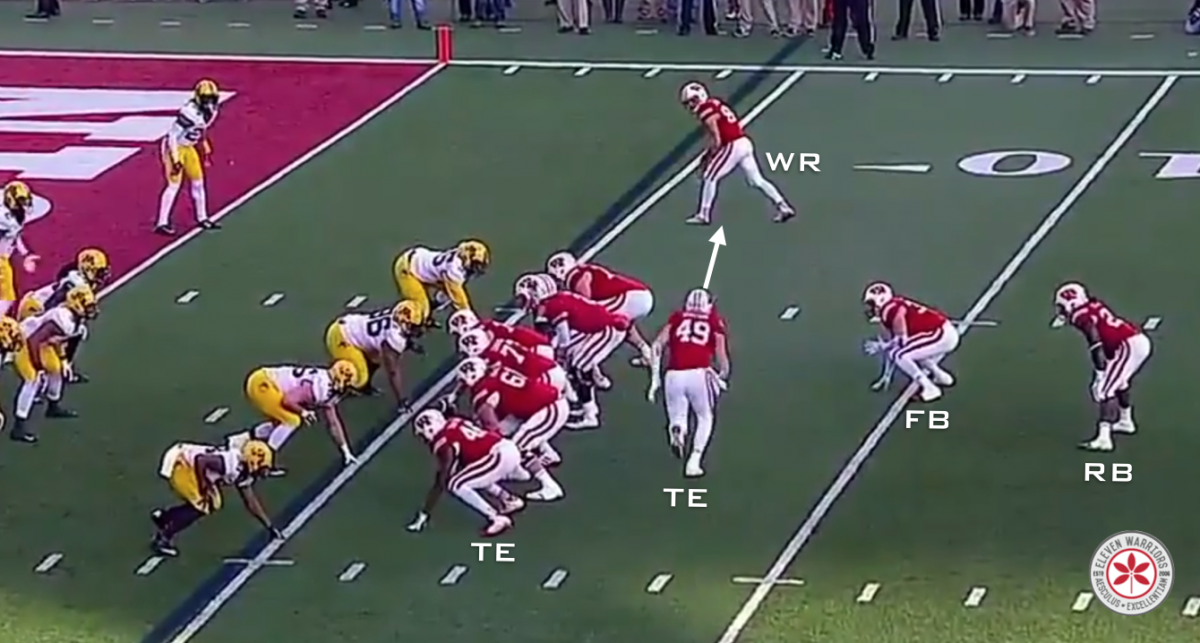
"Flex tight end" Sam Arneson (#49) is the most athletic blocker of the bunch, often lining up off the line of scrimmage and going in motion. After the snap, he'll often come back across the formation though, leading the way for Gordon in the Split Zone, Counter-Trey, or G-Sweep.
Andersen and offensive coordinator Andy Ludwig don't rely on one specific concept, but rather call all kinds of zone and gap-blocking schemes pretty liberally, providing multiple looks from the same formation. While this is clearly a credit to the offensive line and their ability to learn and adapt numerous concepts to different opponents each week, Gordon also deserves a lot of credit for transforming himself from a pure speed back into a strong inside runner.
The junior from Kenosha has gotten stronger every year, and developed enough lower body strength to keep his balance after initial hits, while also gaining the upper body muscle needed to stiff arm countless opponents this fall. Few running backs possess that combination of speed and strength, which has allowed him to turn seemingly broken plays into first downs on a regular basis.

While no team has successfully "stopped" him completely, LSU, Northwestern, and others were able to minimize the damage by getting penetration into the backfield and not allowing him to pick up speed. His patient style makes him a bit of an easy target for oncoming defensive linemen or linebackers when he has to pick a hole and hit the next gear.
But the onus will be on the edge players on the defense, be they outside linebackers, safeties, or even cornerbacks, to not allow him to bounce outside like in the example above. Even when seemingly corralled in the backfield, he still has enough speed to regularly get around the edge if the defender doesn't keep proper leverage.
In last year's meeting, Gordon was held to one of his lowest outputs of the season, and failed to break any long runs as the Buckeyes executed this strategy well all night.

Most importantly though, OSU inside linebackers Josh Perry, Curtis Grant, and Raekwon McMillan can't get caught overrunning plays, as they did against Minnesota and Indiana. The Buckeye defensive line has done a good job of occupying blockers long enough for the linebackers to make plays this fall, but the occasional big play has taken away from an otherwise good job.
As Ross pointed out though, the Buckeye safeties will likely be there to help stop the run more than usual this week. Expect OSU to employ much more man coverage on the outside than normal, allowing Vonn Bell and Tyvis Powell to keep their eyes on Gordon, as the Wisconsin passing game has struggled mightily this fall.
After battling a mental block in the first part of the season, Stave seems to have the confidence in his big arm back. But the only problem is, he doesn't have anywhere to reliably throw the ball.
Receiver Alex Erickson is the team's leading receiver with 44 catches, but is nowhere near the playmaker that the Badgers had in Abbrederis. Compared to the other receivers that cornerbacks Doran Grant and Eli Apple have matched up with this year, like Devin Funchess or Tony Lippett, the Buckeyes should be able to contain Erickson, the only real downfield threat the Badgers possess.
Beyond him though, the Wisconsin passing game is essentially just play-action based off successful Gordon runs, much like what the Buckeyes saw from Minnesota. Arneson is their second-leading target, but has only caught 25 passes for 331 yards, and although he is a threat near the goal-line, the OSU defense should be able to bottle him up if he releases downfield.
More than ever, the Ohio State defense will have to do everything in their power to put the Badgers in passing situations on second or third downs. Ludwig doesn't hesitate to call for play-action on first down, but rarely ever follows up with another on second down.
Even if they give up a few first downs because of it, the Buckeyes should still have faith in their corners playing man coverage though. Joey Bosa, Michael Bennett, and Adolphus Washington caused lots of problems for Stave and the Badger offensive line last year, causing a number of errant throws.

Simply put, the biggest advantage the Buckeyes will have in this game will be when Wisconsin tries to throw the ball. Even if it means putting Grant or Apple on an island on occasion beforehand, OSU has a superior talent advantage when Gordon is no longer the focus.
Defense
Though they operate from a 3-4 look, the Badgers defense often looks more like a classic 4-3 under team from the 80's or 90's, slanting the front five into gaps and looking for the inside linebackers to make plays in the backfield. But just because this group is made up a bunch of names that few outside of Madison would ever recognize, it doesn't mean this group doesn't make plays.
The Badgers have stuffed opposing running games all year long, with only national leader Penn State allowing fewer yards-per-carry in the conference. Strong safety Michael Caputo (#7) leads the team in tackles, often aligning close to the line, and flying up at the first indication of a run to support the front seven, and often giving the opponents more defenders than they can block.
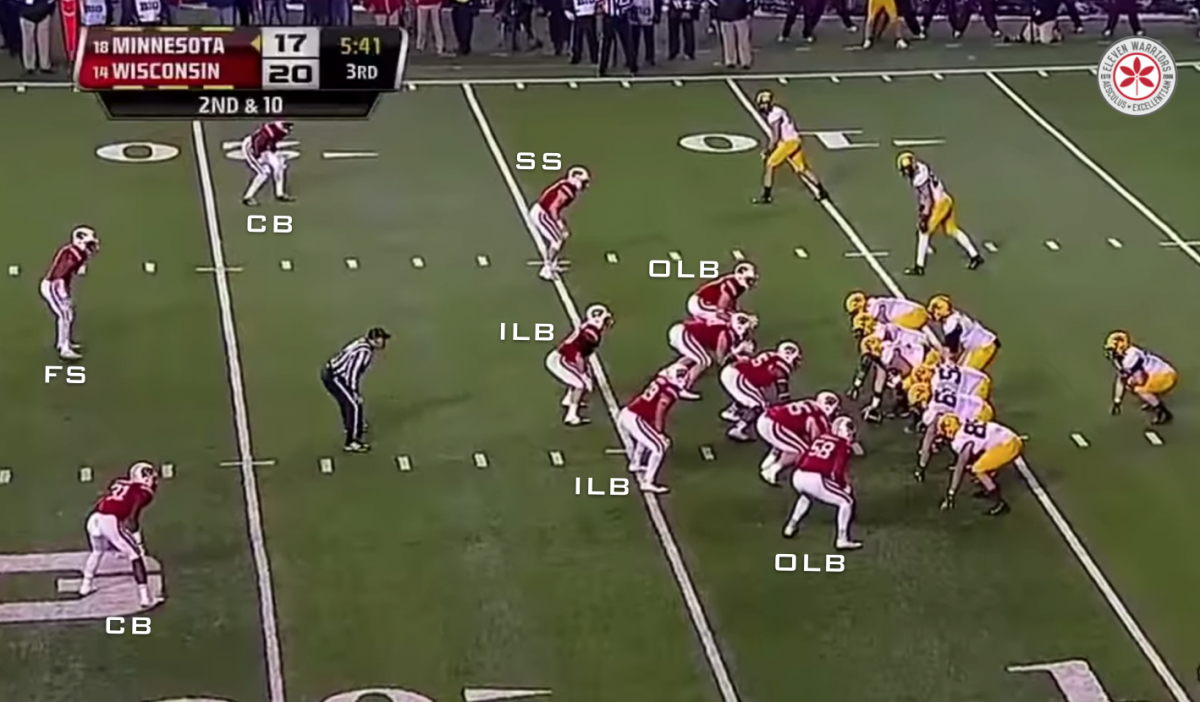
This aggressiveness is the trademark of the Badger defense, as they try to make up for a lack of true size and athleticism with a gambling mentality, looking to simply overwhelm opponents and force them to execute quickly. As Ross also pointed out, the Badgers are very comfortable playing in a "Bear" front, with their three defensive linemen over the center an guards.
But the Buckeye running game seems to have adjusted well to that look after struggling with it against Virginia Tech. Plays like Power, Dart, and QB counter-trey have become core schemes for the OSU offense, regardless of who is taking the snap, so execution shouldn't be an issue with a new player taking snaps.
Outside linebacker Joe Schobert (#58) is the best athlete in the front seven, and uses his quickness to not only make plays for himself, but to disrupt blocking schemes enough for the inside linebackers to fill behind him and make plays.
But the heart of the run defense is former walk-on middle linebacker Marcus Trotter (#59), who has filled the void admirably of 2013 Big Ten defensive player of the year, Chris Borland with 10 tackles-for-loss. Trotter may lack ideal size for the position, but the fifth-year senior has developed excellent instincts allowing him to constantly be around the ball.
Though he played well against LSU and Nebraska, registering 12 tackles in each contest, his played the best game of his career last week against Minnesota, racking up 14 tackles, and playing a central role in slowing down David Cobb.
But in order to play such an aggressive scheme up front, the Badgers are left exposed in the secondary. Often lining up with one deep safety, they alternate between three-deep zone coverage (Cover 3), or man coverage with the safety playing center field (Cover 1).
Andersen and defensive coordinator Dave Aranda put a lot of faith in cornerbacks Darius Hillary and Sojourn Shelton, as the pair are probably the best athletes on the team besides Gordon. But there's only so much these two can do when offenses overload a zone, as the Buckeyes did to Shelton last year, running a "switch" route combo with a post and wheel route which resulted in a deep touchdown.

With the safeties so involved in stopping the run, the slightest hint of run often sucks them up to the line, leaving the corners all alone. There is no bigger offender than Caputo, who has been burned countless times by play-action.

Truly, the gaps in the Wisconsin pass defense are not only over the top, but also in the alleys. Forcing Caputo or Schobert to walk out to cover slot receivers is something they're not overly comfortable with, and will only do so once a team has proven they can throw the ball outside.
It doesn't help that the Badger defensive line isn't a great pass rushing unit on their own, with the majority of pressure coming from blitzing linebackers. On third and long situations, the Badgers will often only leave one or two linemen in the game, replacing them with more linebackers and defensive backs and creating a "UFO" look that disguises who is actually bringing pressure.
With little help from the safeties, the Wisconsin corners often bail quickly, giving opposing receivers a large cushion off the line. Cardale Jones won't have to make extremely difficult throws, as screens and quick hitches, like the Buckeyes successfully used against Michigan State, should force the outside linebackers and safeties to play far less aggressive near the ball and help make tackles on the edges.
Jones shouldn't have to do to much to loosen up the Badger defense, as much of that work should come from his receivers, specifically Jalin Marshall. The Badgers have yet to see a player quite like him, so seeing how they try to defend him specifically will be interesting.
Jet Sweeps and screens were very effective in the Horseshoe last year against this scheme, and while this year's Badger defense is excellent near the line of scrimmage, they've struggled at making tackles in space. Much like we said of J.T. Barrett when he took over under center in August, his top responsibility should be to distribute the ball to the playmakers around him, and that doesn't change for Jones.
As good as the Badgers have been this year on defense, the Buckeyes should have enough weapons, especially on the outside, to give them problems. However, OSU can't get predictable or conservative in their play-calling and must give Jones the opportunity to spread the ball around, even if he misses a couple throws early.
Though the Buckeyes are bigger overall, they shouldn't try to play a ground-and-pound contest on both sides with Wisconsin, as that plays directly to their strengths. Even though it may be uncomfortable at first, OSU must be willing to be as aggressive and not give up faith in Jones' ability to make plays, because if he connects on a deep pass or two, the Badgers will have trouble keeping up.
